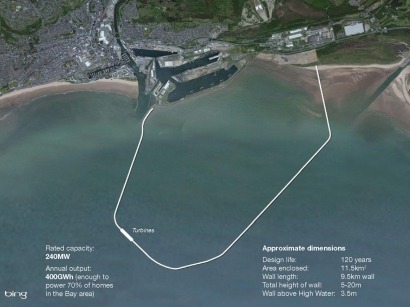
The project has involved three years of feasibility studies and impact assessments, but TLP have now submitted its planning application, consisting of 5,000 pages, for a Development Consent Order (DCO) under the Planning Act (2008). The application has been developed through extensive consultation in Swansea Bay and will now be reviewed by the Planning Inspectorate before public examination and then final determination by the Secretary of State for Energy & Climate Change.
The Swansea Bay Tidal Lagoon would be the largest tidal power plant in the world. It would involve the construction of a 9.5 kilometre sea wall built to capture enough renewable energy to supply over 120,000 homes for 120 years. The energy would be drawn from the power of incoming and outgoing tides.
The project aims to source at least 65 percent of constituent content from the UK, kick-starting a new manufacturing industry and a future export market.
“Until now, tidal energy has been heavily promoted by government and environmentalists as an intuitive source of clean and reliable energy for our island nation, but the business response has focused on relatively small-scale tidal stream devices” said Mark Shorrock, CEO of Tidal Lagoon Power. “The UK has the second highest tidal range in the world and today we are submitting an application for a development that will prove that this resource can be harnessed in a way that makes economic, environmental and social sense. Tidal lagoons offer renewable energy at nuclear scale and thus the investment of hundreds of millions of pounds in UK industries and coastal communities.”
The project will aim to supply 10 percent of the UK’s domestic electricity by building at least five full-scale tidal lagoons in UK waters by 2023, before the UK sees any generation from new nuclear plants. Economies of scale will bring an immediate advantage.
A second lagoon will require a lower level of support than offshore wind, for a renewable power supply that is both long-lived and certain. A third lagoon will be competitive with the support received by new nuclear, but comes without the decommissioning costs and safety concerns.
“Had we invested in tidal lagoons in the 1980’s, by now, and into the next century, we would be generating cheaper power than any other form of supply” Mr Shorrock added.
The Cheltenham-based company has spent three years and many millions in developing its proof-of-concept project, alongside a consortium of internationally-reknown industrial businesses including Atkins, Costain, GE, Alstom, Andritz and Voith. It also has the commitment of infrastructure giant Macquarie to lead the capital financing of the project itself.
A survey consisting of 2,400 questionnaires returned during a statutory consultation with the local community found that 86 percent of Swansea Bay residents support the project, which will provide an amenity for the local community and a unique venue for local, national and international sports, education and arts.
If the application is approved, the construction of the Swansea Bay lagoon will begin in the first half of 2015 with the first power generation expected in 2018.
For additional information:

